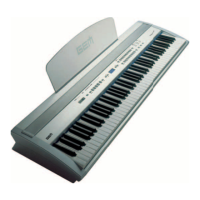
Do you have a question about the GEM Prp700 and is the answer not in the manual?
| Category | Digital Piano |
|---|---|
| Effects | Reverb, Chorus |
| Keyboard | 88-note, weighted hammer action |
| Connectivity | MIDI In/Out |
| Connections | MIDI In/Out |
Illustrates warning symbols and their meanings for electrical safety.
Essential precautions for safe operation, installation, and maintenance.
Volume adjustment, demo playback, recording, and library access functions.
Presets, variations, split, reverb, EFX, and touch settings.
Balance, transpose, and access to instrument functions.
Powering on, initializing, and setting the main volume.
Connecting headphones and learning through demo songs.
Choosing and applying different sound presets and their variations.
Combining multiple presets to create layered sounds.
Detailed guide to layering presets with their variations.
Dividing the keyboard for different sounds in left and right sections.
Adjusting volume mix between sounds in a layered preset.
Choosing from various reverb sound effects.
Customizing reverb amount applied to different sections.
Choosing from available audio effects like Delay, Chorus.
Adjusting effect amount sent to different sound sections.
Adjusting keyboard sensitivity to playing dynamics.
Setting a static, non-velocity-sensitive keyboard response.
Shifting the overall pitch of the instrument.
Activating and playing with the built-in metronome.
Adjusting time signature, accent, and volume.
Guide to preparing and recording songs onto tracks.
Understanding continue and start modes for playback.
Adding a second performance track for practice or layering.
Deleting individual tracks from the sequencer.
Clearing all recorded song data from memory.
Choosing between adding or overwriting during recording.
Using metronome settings to guide song recording.
Choosing and playing songs from the internal library.
Using piano keys to select songs from the library.
Disabling left or right hand parts for focused practice.
Modifying the playback speed of library songs.
Setting loop points for sections within songs.
Selecting various tuning temperaments.
Fine-tuning the overall pitch of the instrument.
Configuring MIDI input channels and modes.
Configuring MIDI output channels and modes.
Managing MIDI local control for network setup.
Editing MIDI note data transmission.
Filtering MIDI control and program change messages.
Selecting factory or user startup settings.
Saving song data to an external MIDI sequencer.
Setting the piano's USB port mode.
Editing reverb parameters like depth and time.
Editing effect parameters such as depth and type.
Turning the internal equalizer on or off.
Enabling or disabling the damper physical model.
Selecting damper pedal decay modes.
Controlling the power LED status.
Overview of the advanced DSP engine powering the piano.
Explanation of sound creation through mathematical models.
Simulating sympathetic string resonance for realistic piano sound.
Modeling sympathetic resonance from the damper pedal.
Simulating string damping and harmonic dissipation upon key release.
Technology for seamless dynamic changes based on key velocity.